This article has multiple issues. Please help improve it or discuss these issues on the talk page . (Learn how and when to remove these template messages)
|
Artur Kejza (born 8 March 1974) is a Polish practitioner of judo.
This article has multiple issues. Please help improve it or discuss these issues on the talk page . (Learn how and when to remove these template messages)
|
Artur Kejza (born 8 March 1974) is a Polish practitioner of judo.
| Year | Tournament | Place | Weight class |
|---|---|---|---|
| 1997 | European Judo Championships | 5th | Middleweight (86 kg) |

Grappling, in hand-to-hand combat, describes sports that consist of gripping or seizing the opponent. Grappling is used at close range to gain a physical advantage over an opponent, either by imposing a position or causing injury. Grappling is a broad term that encompasses many disciplines. These various martial arts can be practiced both as combat sports and for self-defense. Grappling contests often involve takedowns and ground control, and may end when a contestant concedes defeat, also known as a submission or tap out.
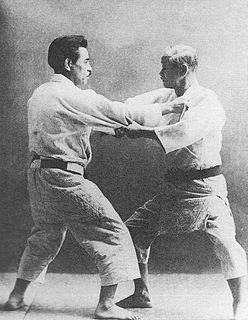
Judo is a system of unarmed combat, modern Japanese martial art and Olympic sport. Judo was created in 1882 by Jigoro Kano (嘉納治五郎) as an eclectic martial art, distinguishing itself from its predecessors due to an emphasis on "randori" instead of "kata" alongside its removal of striking and weapon training elements. Judo rose to prominence for its dominance over established jujutsu schools in tournaments hosted by the Tokyo Metropolitan Police Department, resulting in its adoption as the department's primary martial art. As "jujutsu" was a Japanese term referring to this sub-type of martial arts in general, Judo was colloquially known as Kano Jujutsu or Kano Ryu to differentiate it from other jujutsu schools; this naming convention decreased in prominence due to the adoption of the formal name of Judo. A judo practitioner is called a "judoka", and the judo uniform is called "judogi".
Martial arts are codified systems and traditions of combat practiced for a number of reasons such as self-defense; military and law enforcement applications; competition; physical, mental, and spiritual development; entertainment; and the preservation of a nation's intangible cultural heritage.

Budō is a Japanese term describing modern Japanese martial arts. Literally translated it means the "Martial Way", and may be thought of as the "Way of War" or the "Way of Martial Arts".

Mixed martial arts (MMA), sometimes referred to as cage fighting, no holds barred (NHB), and ultimate fighting, is a full-contact combat sport based on striking, grappling and ground fighting, incorporating techniques from various combat sports including boxing, kickboxing and martial arts from around the world. The first documented use of the term mixed martial arts was in a review of UFC 1 by television critic Howard Rosenberg in 1993. The question of who actually coined the term is subject to debate.
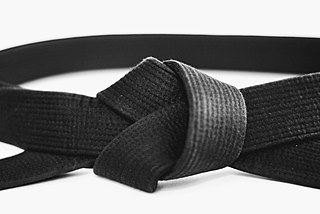
In East Asian martial arts, the black belt is associated with expertise, but may indicate only competence, depending on the martial art. The use of colored belts is a relatively recent invention dating from the 1880s.
The following outline is provided as an overview of and topical guide to martial arts:
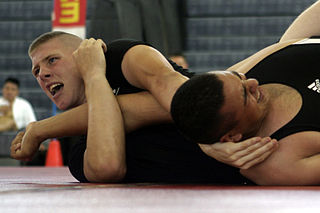
Submission wrestling, also known as Submission fighting, Submission grappling or Sport grappling, is a form of competition and a general term for martial arts and combat sports that focus on clinch and ground fighting with the aim of obtaining a submission through the use of submission holds. The term "submission wrestling" usually refers only to the form of competition and training that does not use a gi, or "combat kimono", of the sort often worn with belts that establish rank by color, though some may use the loose trousers of such a uniform, without the jacket. Not using a gi has a major impact on the sport : there are many choke techniques which make use of the lapels of the gi, thus rendering them un-usable and grappling in general becomes more difficult when the opponent doesn't have a gi to grab hold of.
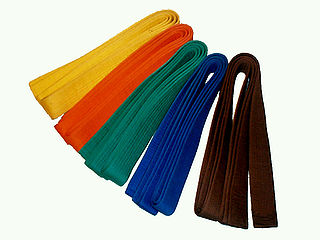
Kyū is a Japanese term used in modern martial arts as well as in tea ceremony, flower arranging, Go, shogi, academic tests and other similar activities to designate various grades, levels or degrees of proficiency or experience. In Mandarin Chinese, the same character 級 is pronounced jí, and the term is used for academic tests. In Korea, the term geup is used. In Vietnamese martial arts, it is known as cấp (khớp).
Shoot wrestling is a combat sport that originated in Japan's professional wrestling circuit of the 1970s. Professional wrestlers of that era attempted to use more realistic or even "full contact" moves in their matches to increase their excitement. The name "shoot wrestling" comes from the professional wrestling term "shoot", which refers to any unscripted occurrence within a scripted wrestling event. Prior to the emergence of the current sport of shoot wrestling, the term was commonly used in the professional wrestling business, particularly in the United Kingdom, as a synonym for the sport of catch wrestling. Shoot wrestling can be used to describe a range of hybrid fighting systems such as shootfighting, shoot boxing and the styles of mixed martial arts done in the Shooto, Pancrase and RINGS promotions.
Keikogi (稽古着), also known as dōgi (道着) or keikoi (稽古衣), is a uniform worn for training in Japanese martial arts and their derivatives. Emerging in the late 19th century, the keikogi was developed by judo founder Kanō Jigorō.

Kata is a Japanese word meaning "form". It refers to a detailed choreographed pattern of martial arts movements made to be practised alone. It can also be reviewed within groups and in unison when training. It is practised in Japanese martial arts as a way to memorize and perfect the movements being executed. Korean martial arts with Japanese influence use the derived term hyeong and also the term pumsae.
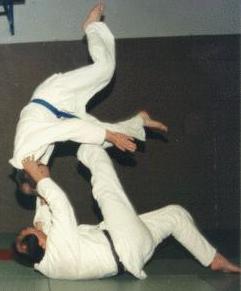
In martial arts, a throw is a grappling technique that involves off-balancing or lifting an opponent, and throwing them to the ground, in Japanese martial arts referred to as nage-waza, 投げ技, "throwing technique". Throws are a subset of takedown (grappling). Certain throwing techniques called sacrifice throws involve putting oneself in a potentially disadvantageous position, such as on the ground, in order to execute a throw.
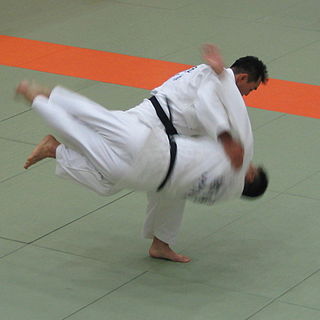
Harai goshi (払腰) is one of the original 40 throws of Judo as developed by Kano Jigoro. It belongs to the second group of the traditional throwing list in the Gokyo no waza of the Kodokan Judo. It is also part of the current 67 Throws of Kodokan Judo, and classified as a hip technique (koshiwaza). Harai goshi is also one of the 20 techniques in Danzan ryu's Nagete list as well as one of the 18 throws in the Kar-do-Jitsu-Ryu martial arts system. English terms include "Sweeping hip throw" and "Hip Sweep".

Brian Jacks is a British judoka who won Britain's first medal at a world championship, taking a bronze in Salt Lake City in 1967, and gained a second bronze at the 1972 Munich Olympics.
Ireneusz Kwieciński is a Polish judoka.
Paweł Smoliniec is a Polish judoka.

Jujutsu, also known as jiu-jitsu and ju-jitsu, is a family of Japanese martial arts and a system of close combat that can be used in a defensive or offensive manner to kill or subdue one or more weaponless or armed and armored opponents. A subset of techniques from certain styles of jujutsu was used to develop many modern martial arts and combat sports, such as judo, aikido, sambo, ARB, Brazilian jiu-jitsu, and mixed martial arts.
The year 2015 is the 12th year in the history of the Konfrontacja Sztuk Walki, a mixed martial arts promotion based in Poland. In 2015 Konfrontacja Sztuk Walki held 4 events beginning with, KSW 30.
The year 2017 is the 14th year in the history of the Konfrontacja Sztuk Walki, a mixed martial arts promotion based in Poland. 2017 began with KSW 38.